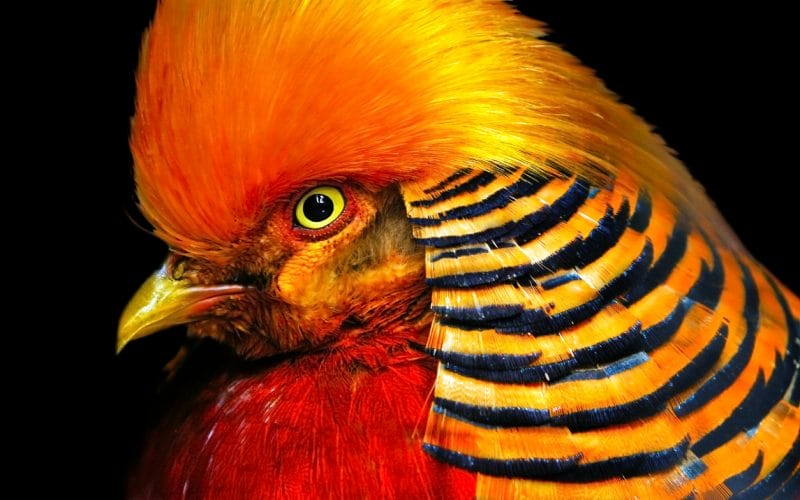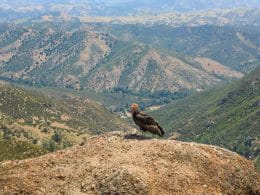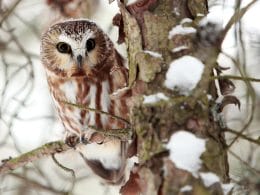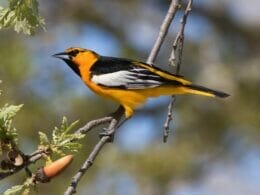Birds come in all shapes and colors. That’s what makes birdwatching so thrilling!
Once you look into it, you’ll realize that there are a lot of birds with orange chest feathers, and they’re similar in a bunch of ways.
Telling those graceful creatures apart is a skill to master.
In this post, we go over a list of 21 feathered friends with orange chests and what makes them unique. Let’s dig in!
21 Birds with Orange Chests
From bright flame to a subtle buff tone, each bird has its own way of reflecting its carotene pigmentation.
Here’s a list of some of birds with the prettiest orange shades you’ll ever spot:
1. Scarlet Tanager Songbird
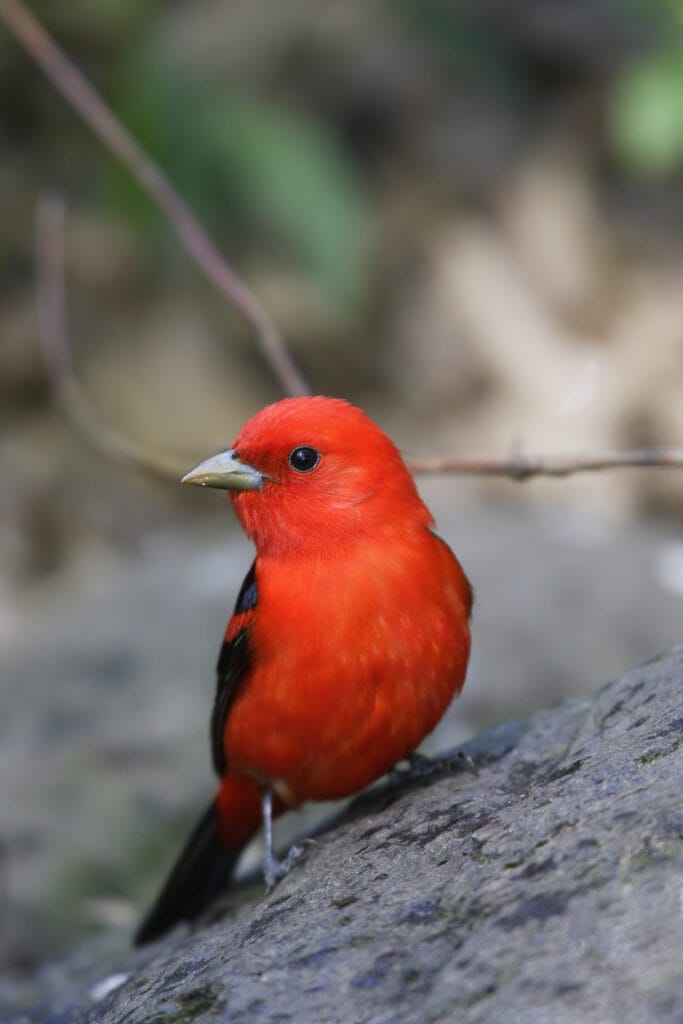
- Scientific name: Piranga olivacea
- Wingspan: 10 in
- Length: 6.5 in
- Weight: 1.02 oz
You won’t have a hard time telling the Scarlet tanager from other Piranga species since each has its distinctive color, especially the male ones.
For instance, the Western Tanager is a vivid yellow, and the Summer Tanager’s plumage is red all over.
It’s with the Flame-colored Tanager that things get a bit complicated since their chests are almost the same hue of orange.
Top Tip: To tell them apart, you’ll have to take a look at their wings. Scarlet ones have solid black wings, while the flame-colored ones are patterned gray-ish.
If you visit evergreen forests in the eastern part of the States, you might get lucky and come across any of those orange-breasted beauties!
2. Blackburnian Warbler
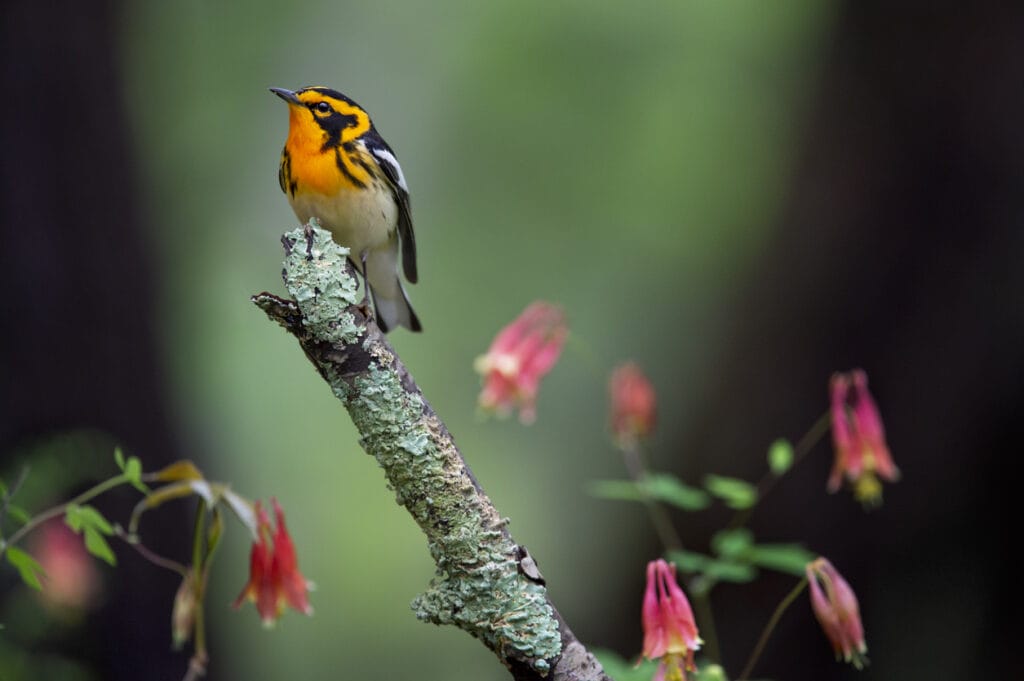
- Scientific name: Setophaga fusca
- Wingspan: 8 in
- Length: 3.7-7.5 in
- Weight: 0.34 oz
The warbler is a notoriously good flier that visits America twice annually, and it prefers coniferous trees during the summer.
Its chest is a faded hue somewhere between yellow and orange, but the eyeliner-like patterns on its face are very sharp and striking.
If you see the white marking on the side of its black wing, you can say for sure that you’ve seen a Blackburnian Warbler!
3. House Finch
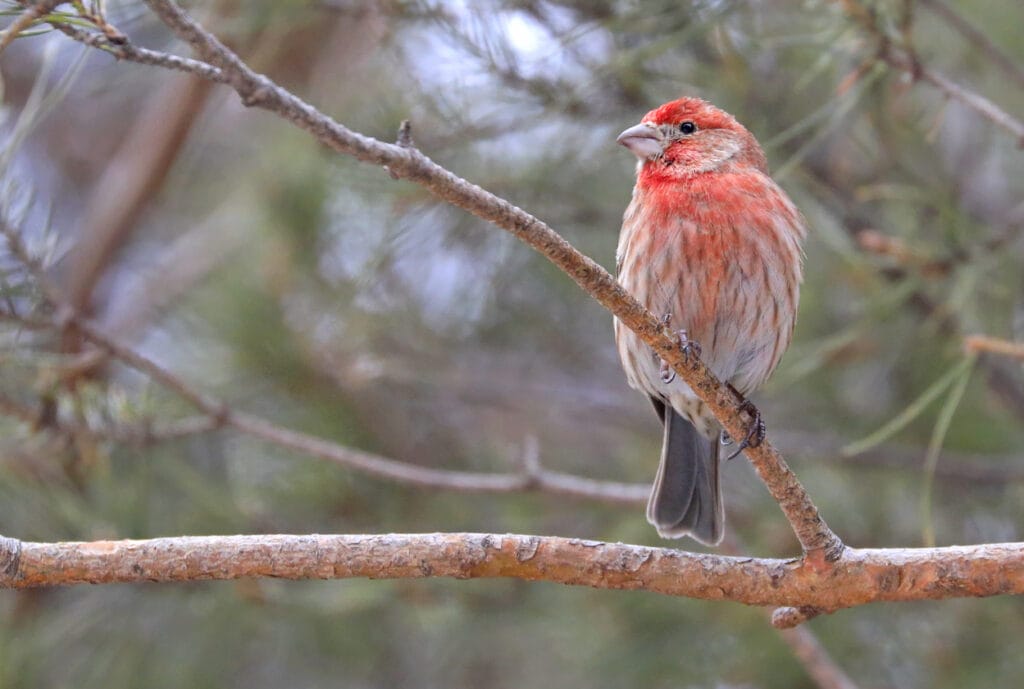
- Scientific name: Haemorhous mexicanus
- Wingspan: 10 in
- Length: 5.5 in
- Weight: 0.7 oz
Even in urban centers, you can spot the cheerful House Finch from coast to coast. Don’t be surprised if you spot it in your own backyard!
However, only adult male birds have this visibly orange chest. During molting, it’s easier to see the true orange color.
Plus, the bird’s diet can play a role in its plumage color, thanks to carotenoid pigments. That’s why its chest can be a vivid red, a muted orange, or a pale yellow.
4. Eurasian Bullfinch
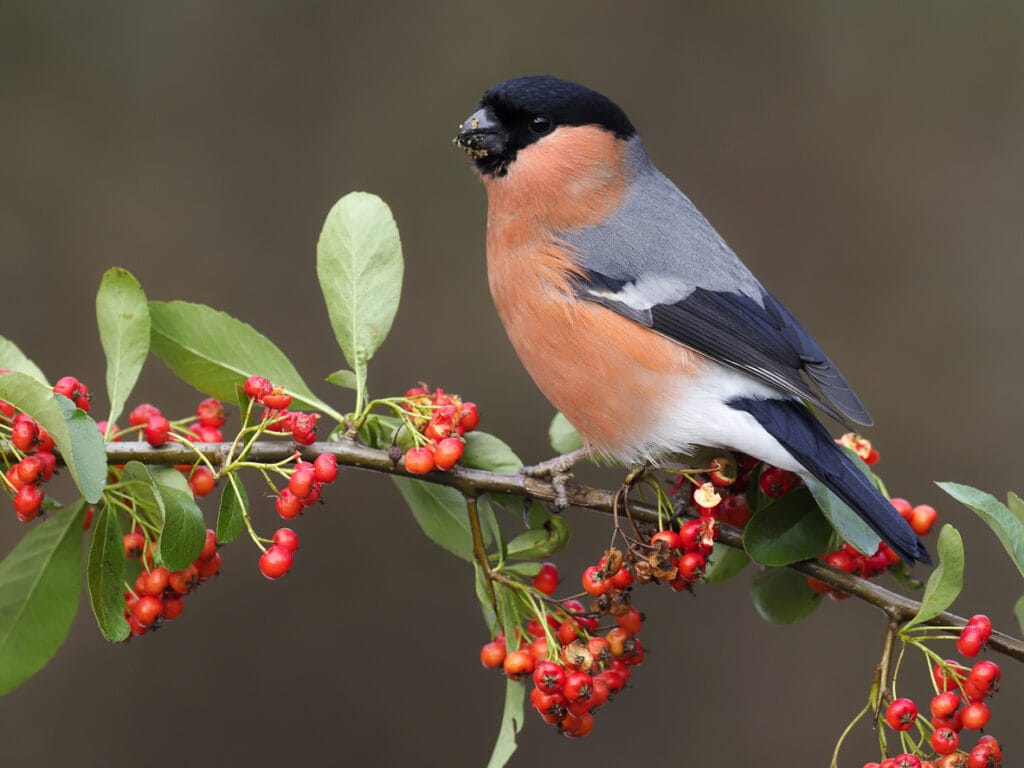
- Scientific name: P. pyrrhula
- Wingspan: 10 in
- Length: 6.5 in
- Weight: 0.8 oz
Male Bullfinches have quite the color palette, from the gray mantle going to the orange chest and up to the white rump.
Author Note: Sadly, it’s not as common as other birds on the list. It’s not even native to the States, but if you’re lucky enough to come across one of those, their bulky appearance is unmistakable!
5. Chaffinch
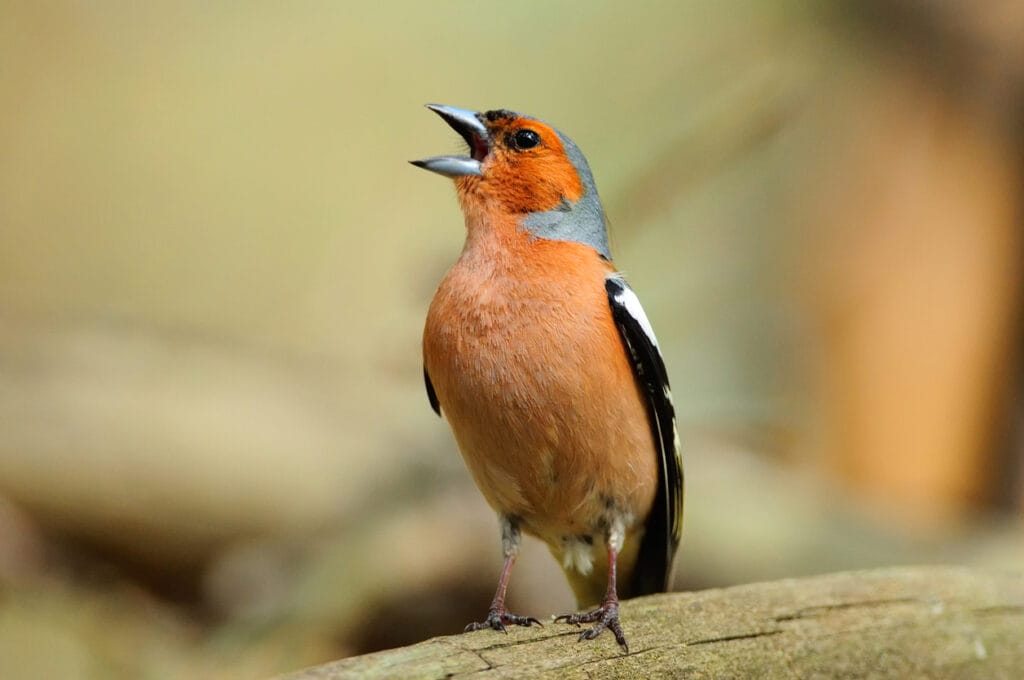
- Scientific name: Fringilla coelebs
- Wingspan: 10 in
- Length: 5.7 in
- Weight: 0.8-1 oz
The Chaffinch is a UK bird known for its sharp profile from a grayish top to an orange throat and chest.
Unlike the Eurasian Bullfinch, the chest of the chaffinch is more of a burnt color than a vivid flame-like orange.
This shade gets even darker as the weather gets colder. In the winter, Chaffinches usually travel with flocks of Brambling.
6. Brambling
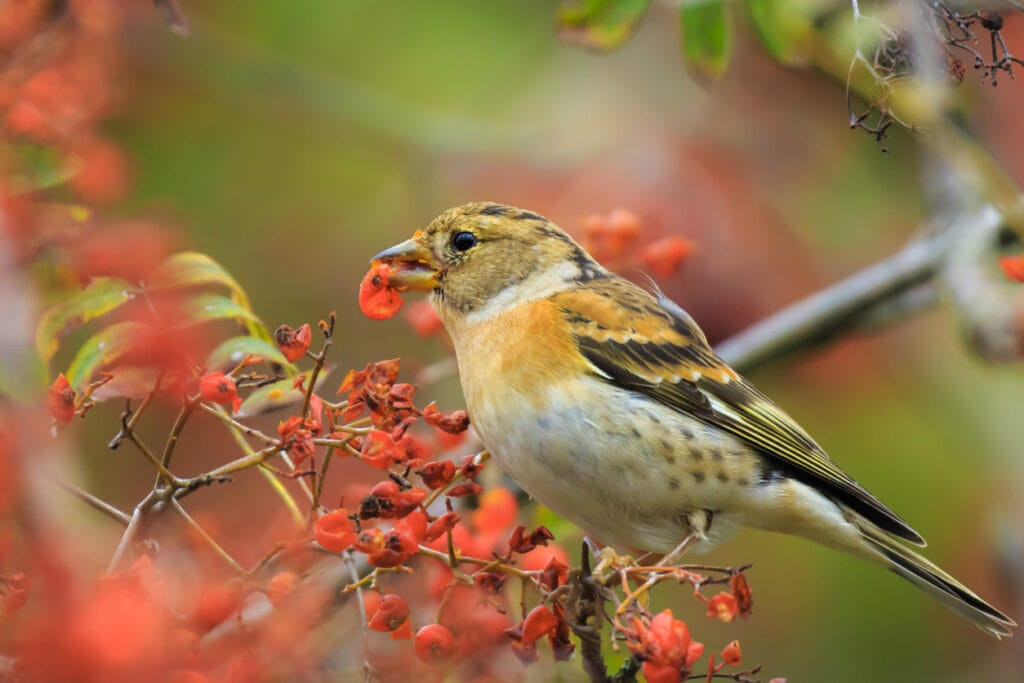
- Scientific name: Fringilla montifringilla
- Wingspan: 10 in
- Length: 5.5 in
- Weight: 0.8 oz
The Brambling is a small passerine type of finch native to Europe and Asia. With a glossy black head and orange underparts, it’s often confused with the chaffinch.
To see the sharpest hue of this bird’s orange chest, you’ll have to spot a male showing off its breeding plumage.
It’s regularly spotted in Alaska during the migration, and some stray all the way down south to Colorado. In urban areas, it’s definitely not a shy bird, and it might even use bird feeders.
7. European Stonechat
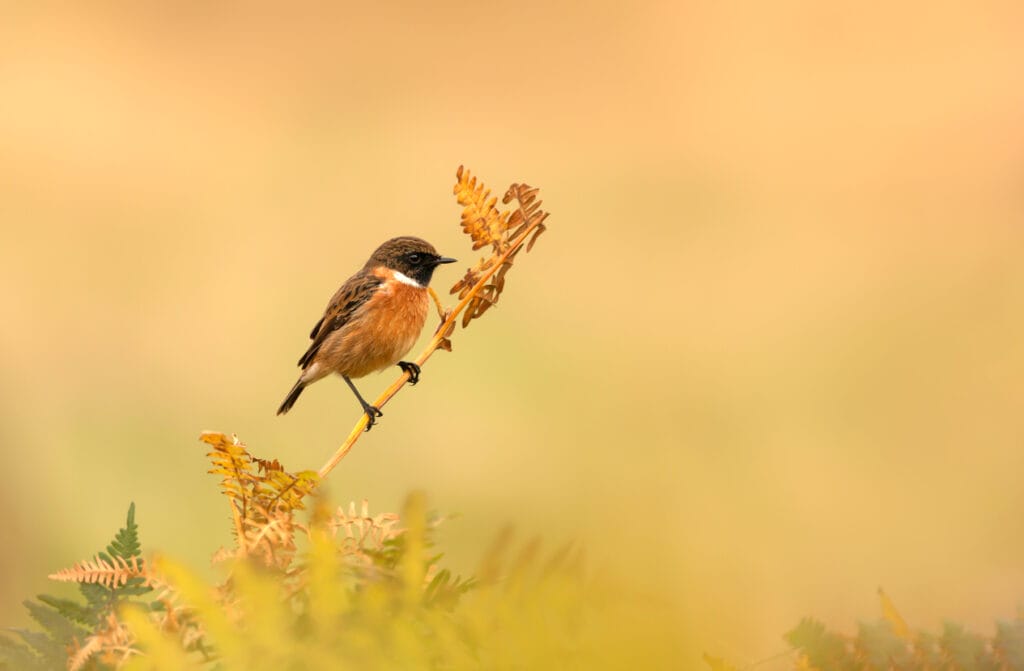
- Scientific name: Saxicola rubicola
- Wingspan: 7-8 in
- Length: 5 in
- Weight: 0.5 oz
The European Stonechat is a perky lover of the open country, so it’s not hard to spot if you know where to look.
Author Note: Both male and female Stonechat are orange-chested. However, you can tell them apart by their head color since males are black on top.
Don’t rush with your identification, though. It’s eerily similar to the Whinchat!
8. Whinchat
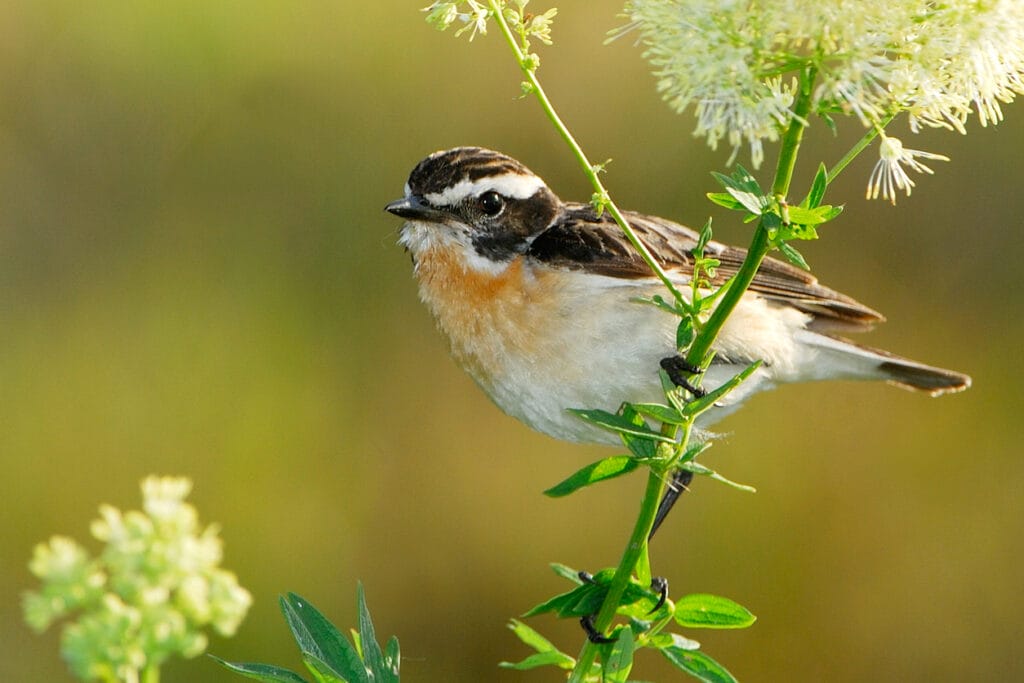
- Scientific name: Saxicola rubetra
- Wingspan: 8-9.5 in
- Length: 5 in
- Weight: 0.7 oz
To the casual observer, the Stonechats and Whinchats are indistinguishable. In fact, both are closely related.
However, Whinchats have a white streak on the side of the eye, while stonechats don’t. Plus, the orange tinge on the whinchats is usually paler.
The sad news here is that the whinchat is now considered an endangered bird on the RSPB’s Red List.
9. Common Redstart
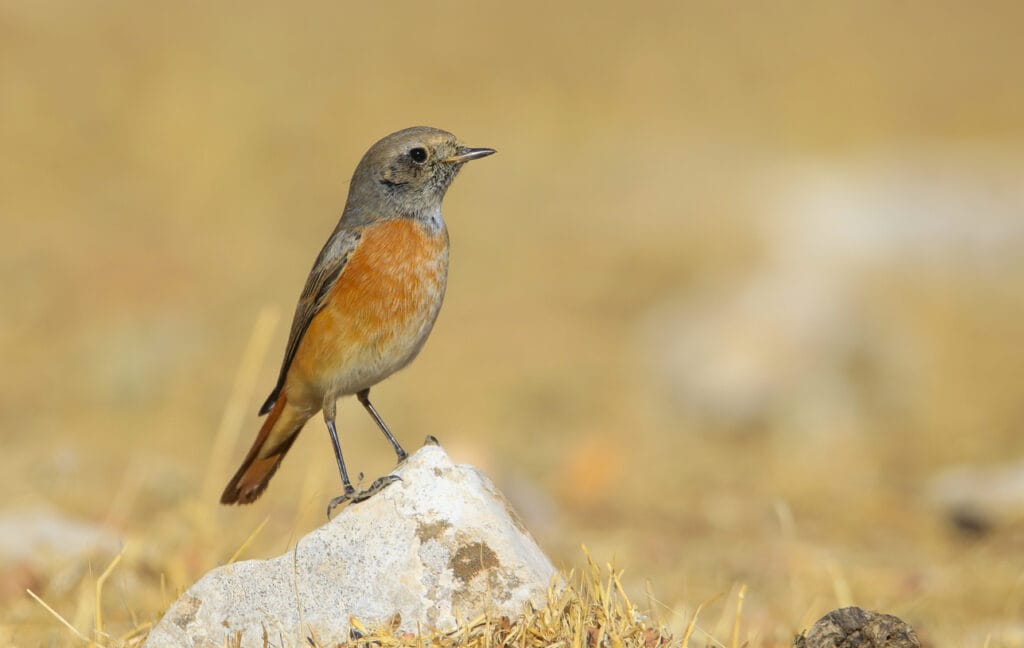
- Scientific name: Phoenicurus phoenicurus
- Wingspan: 8 in
- Length: 5.5 in
- Weight: 0.5 oz
The common variety of the redstart has an orange chest that contrasts with a solid black face and helmet-like wash of gray. On the first glimpse, it looks a bit like a robin.
Keep in mind that only the male birds have these vivid colors. The female counterparts are much faded.
Don’t confuse it with the American Redstart (Setophaga ruticilla) bird, though. Both birds share a name, but they aren’t even related.
The American one’s chest isn’t entirely orange. It’s mostly full of white underparts with bright orange on the sides.
10. Northern Red Bishop
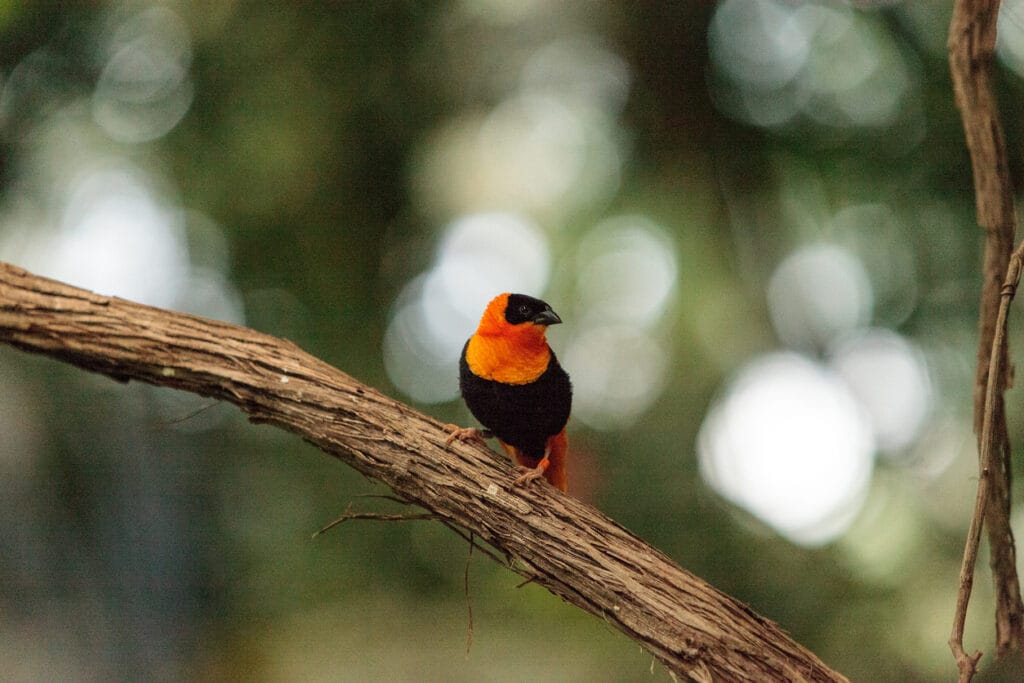
- Scientific name: Euplectes franciscanus
- Wingspan: 8 in
- Length: 5.5 in
- Weight: 0.6 oz
The Northern Red Bishop is a small weaver finch native to Africa, but you can spot it in Florida, Texas, California, and Mexico.
Although its population in the States is very low, it’s not considered endangered. That’s because it’s still abundant in its native habitat.
With the expectation of the wings, crown, and belly, the entire male bird is covered in a bold orange plumage.
Originally, the variety was called the orange bishop. When it was introduced to the States, that’s when the name changed.
11. Barn Swallow
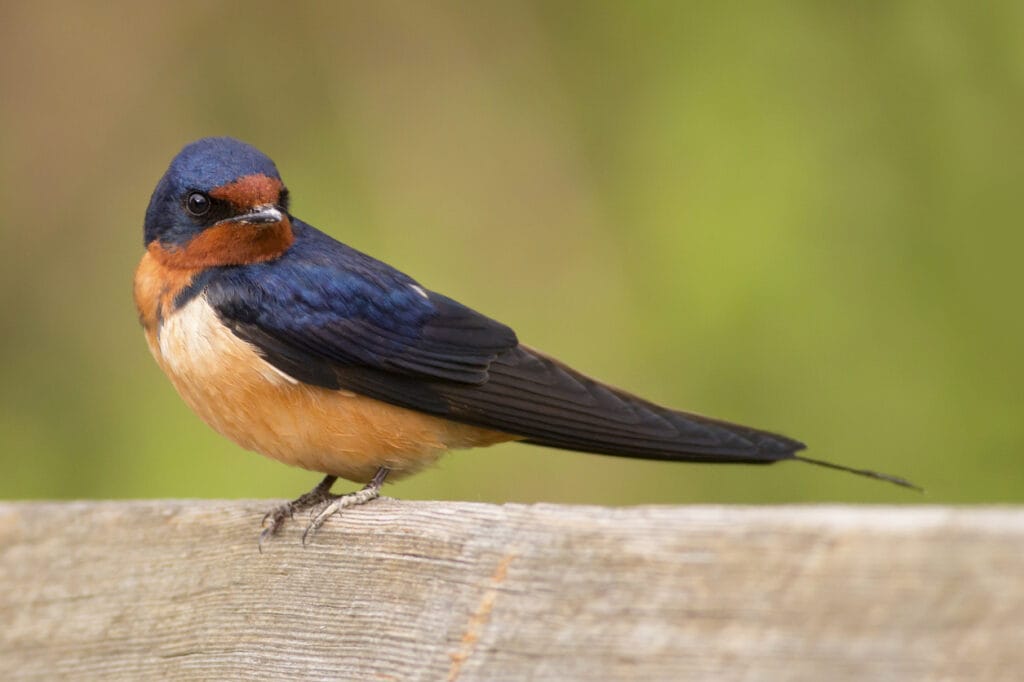
- Scientific name: Hirundo rustica
- Wingspan: 13 in
- Length: 6.25 in
- Weight: 0.65 oz
The Barn Swallow’s wings are a cobalt blue with a tawny shade of orange on the underpart that blends into a forked tail.
As the name implies, this swallow doesn’t shy from human constructions, and it usually nests for breeding in cup-shaped nests around barns all over America.
Because it’s an aerial forager, it’s easy to spot the full wing in flight. You can’t mistake this metallic-blue wing, even from a distance!
12. Bluebird
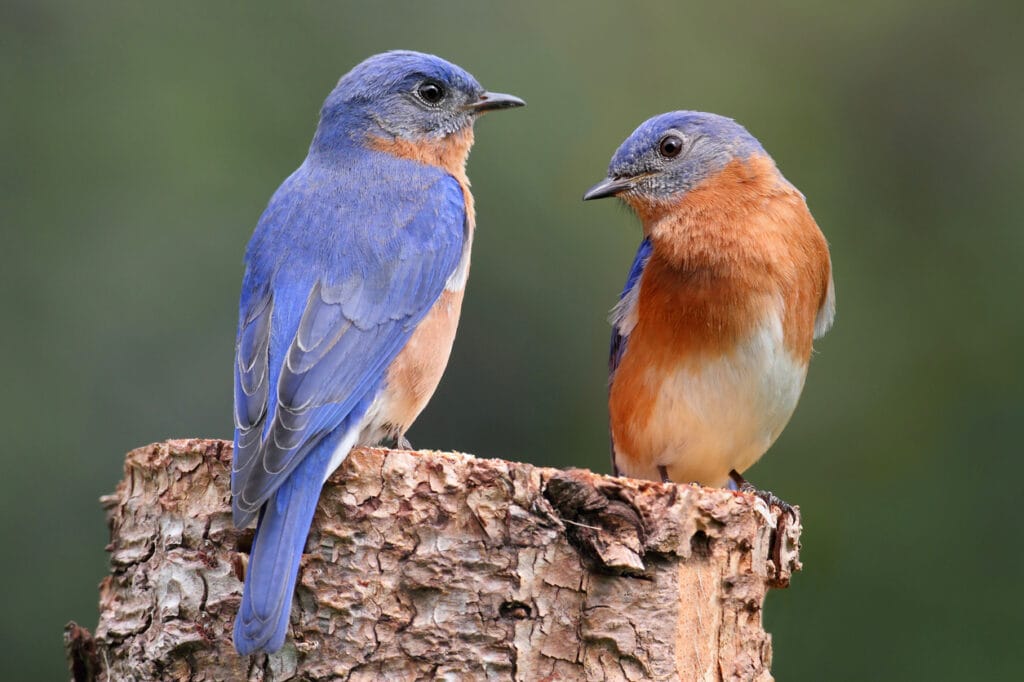
- Scientific name: Sialia sialis or S. mexicana
- Wingspan: 11 in
- Length: 7 in
- Weight: 0.8 oz
Birds usually have a fair indicator that explains their name, and bluebird thrushes are living proof.
While this bird’s wings are also bright blue, it’s not as metallic-looking as the barn swallow.
Author Note: Depending on where you are in the States, you can either spot the eastern or the western variety. Both are highly similar, but the western one has a bit of blue on its neck.
A little fun fact about the orange-chested bluebirds is that females sacrifice a component of their blood to lay blue eggs!
13. American Woodcock
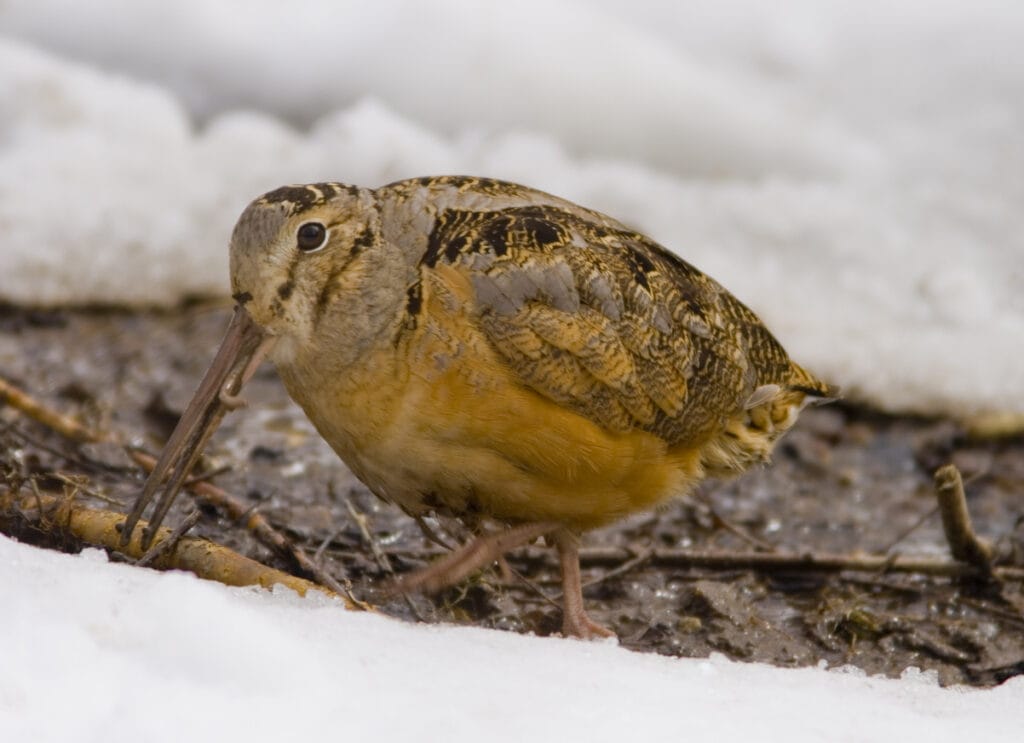
- Scientific name: Scolopax minor
- Wingspan: 6.5-7.7 in
- Length: 10-12 in
- Weight: 7 oz
The American Woodcock is a small but chubby bird commonly spotted in the eastern parts of North America.
Its chest and belly are more of a tan-like orange. Some people even consider it more buff than orange.
Yet, that’s not the most notable feature of the bird’s appearance since its iconically long bill is the first thing that catches your eyes.
The bird is mostly nocturnal. During the day, it prefers nesting in trees, and that’s probably where the common name “timberdoodle” comes from!
14. Eurasian Hoopoe
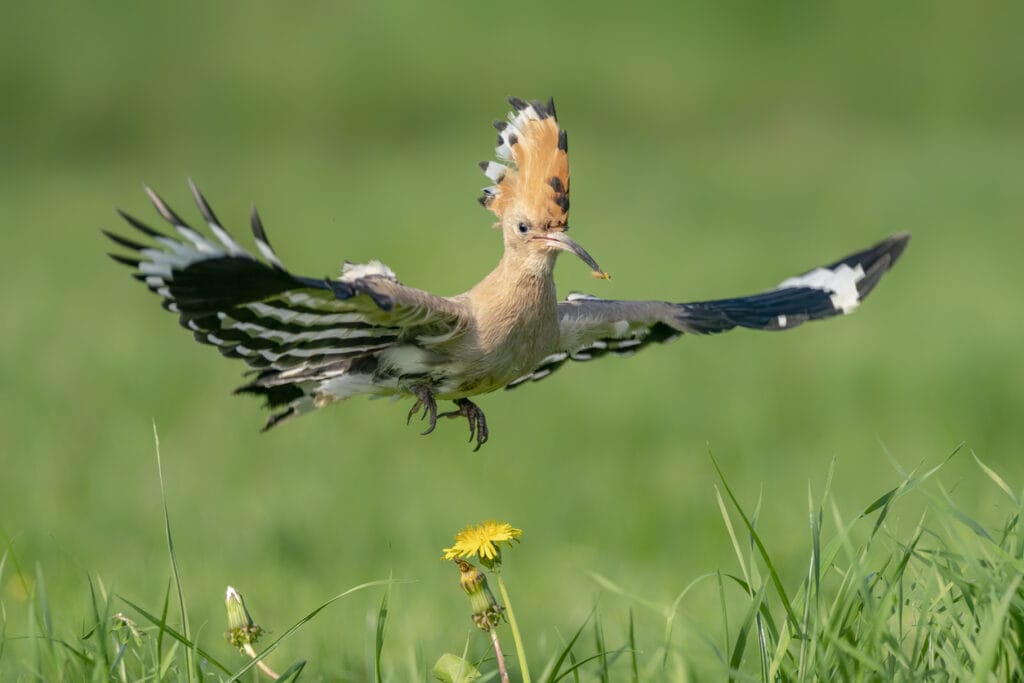
- Scientific name: Upupa epops
- Wingspan: 18 in
- Length: 11 in
- Weight: 2.3 oz
The Eurasian Hoopoe is one of those birds that’s so hard to mistake for any other. It has an outstanding appearance, from its zebra-like wings to the crest fan.
The top half of the bird’s body is orange with hints of buff, but its subtlety pairs perfectly with the pointed bill and the extravagant zebra pattern on the bottom.
In its posture, nesting, and even songs, the hoopoe resembles a woodpecker, but they’re not related at all.
It’s extremely rare to spot one of those dazzling hoopoes in North America. You might have better luck in southern Asia, northern parts of Africa, and the majority of Europe.
15. Golden-Breasted Waxbill
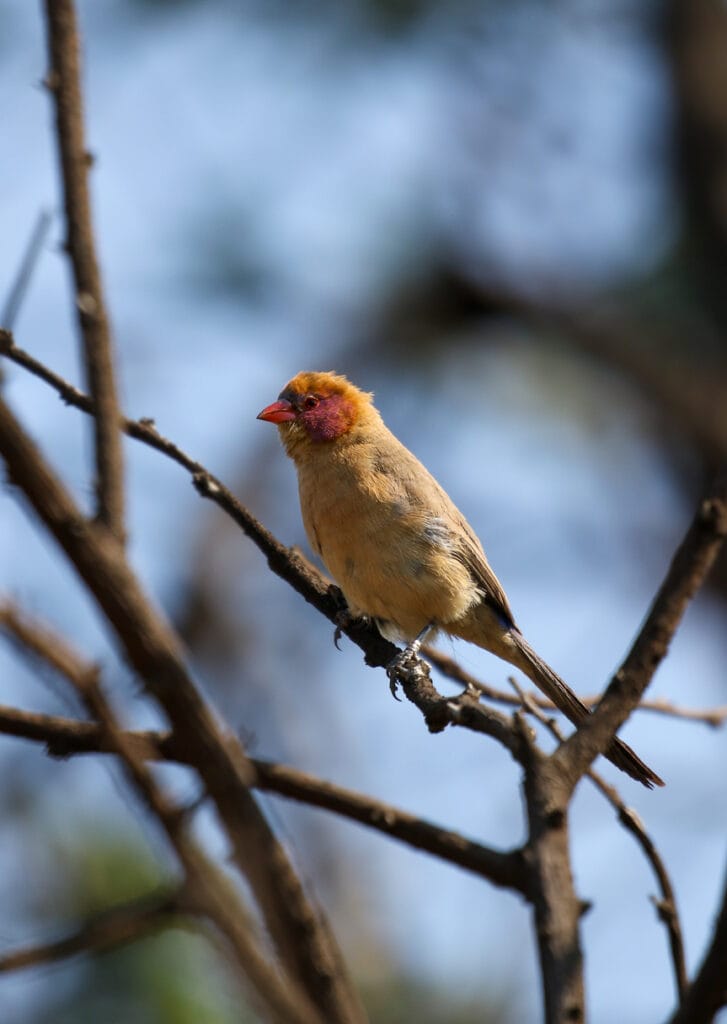
- Scientific name: Amandava subflava
- Wingspan: 3.5 in
- Length: 3.4-4 in
- Weight: 0.2 oz
The Golden-breasted Waxbill (also called the Zebra Waxbill) is one of Africa’s smallest sparrow-like finches.
Like the Northern Red Bishop, this waxbill is native to Africa. It has been introduced to Australia, Saudi Arabia, and Kuwait.
What’s unique about this bird is how its golden-orange chest blends in with an olive green plumage and a bright red bill. Even its irises are reddish!
With this vivid pallet and prideful pose, it can look a bit like a tiny parrot from a distance.
To tell both sexes apart, you have to get close and examine the face. Females lack the black eyebrow-like marking that males have.
16. American Robin
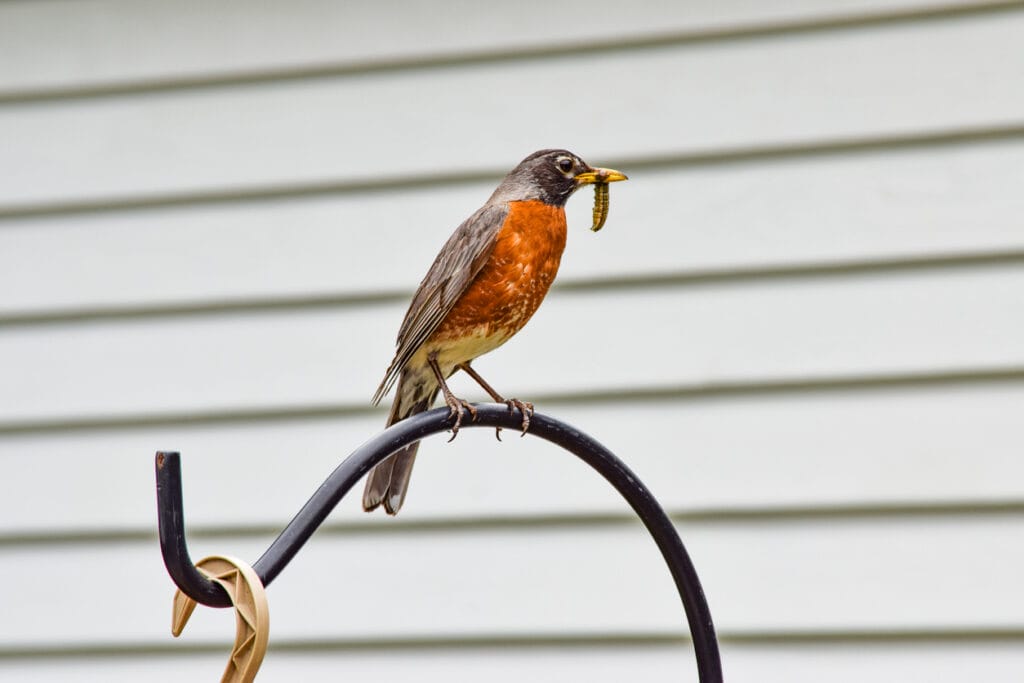
- Scientific name: Turdus migratorius
- Wingspan: 12-16 in
- Length: 10 in
- Weight: 2.7 oz
This robin is one of the most common birds across the States, especially around open grassland in Central America. In fact, it’s considered the State bird for Connecticut, Wisconsin, and Michigan!
During the breeding season, it heads to the north. Meanwhile, it winters a bit to the south in an attempt to escape the freezing habitats.
Top Tip: Both males and females have warm orange feathers over their chest and belly, contrasted with a black head and brown back. Usually, it lifts its bright yellow bill upwards.
17. Red-breasted Nuthatch
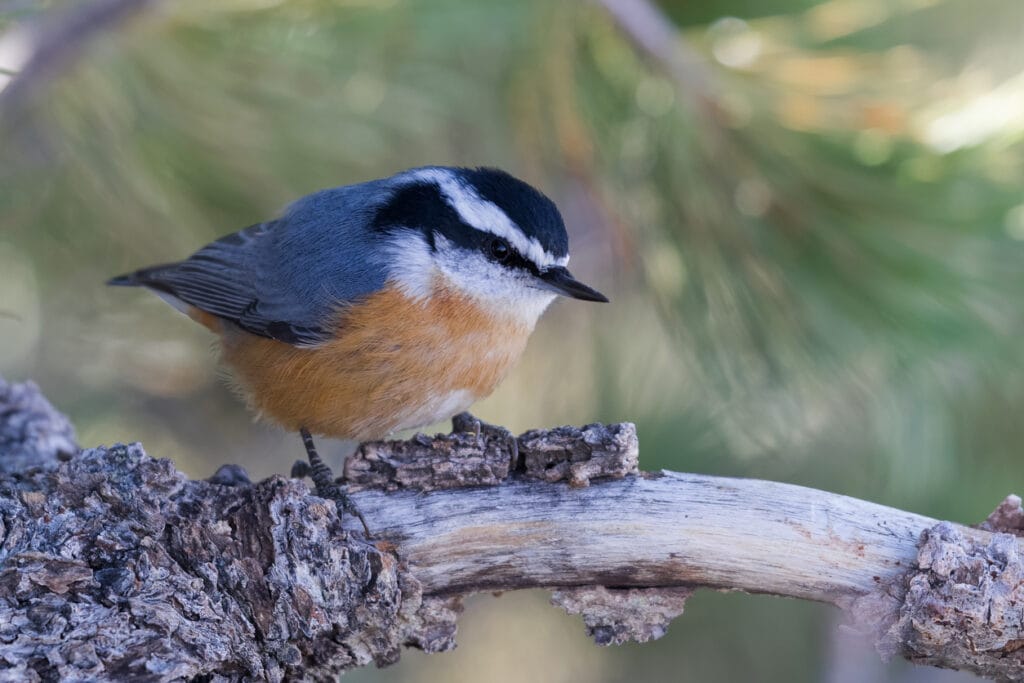
- Scientific name: Sitta canadensis
- Wingspan: 7.5 in
- Length: 4.3 in
- Weight: 0.4 oz
The Red-breasted Nnuthatch is a shy bird that likes to hang upside down on tree bark. It then descends by hopping or walking in a zig-zag motion.
Instead of a vivid orange chest, the nuthatch has a cinnamon-like shade on its underparts. On top, sharp black and white lines lead to bluish-gray wings.
Although it’s subtle, this rust-like shade on their chests is what differentiates them from the Pygmy Nuthatch.
If you’re in a coniferous forest in the northern States, keep your ears open for a nasal and high-pitched honk-like call from the trees. You might just get lucky and spot one, but keep your distance, though. They aren’t the friendliest species!
18. Black-headed Grosbeak
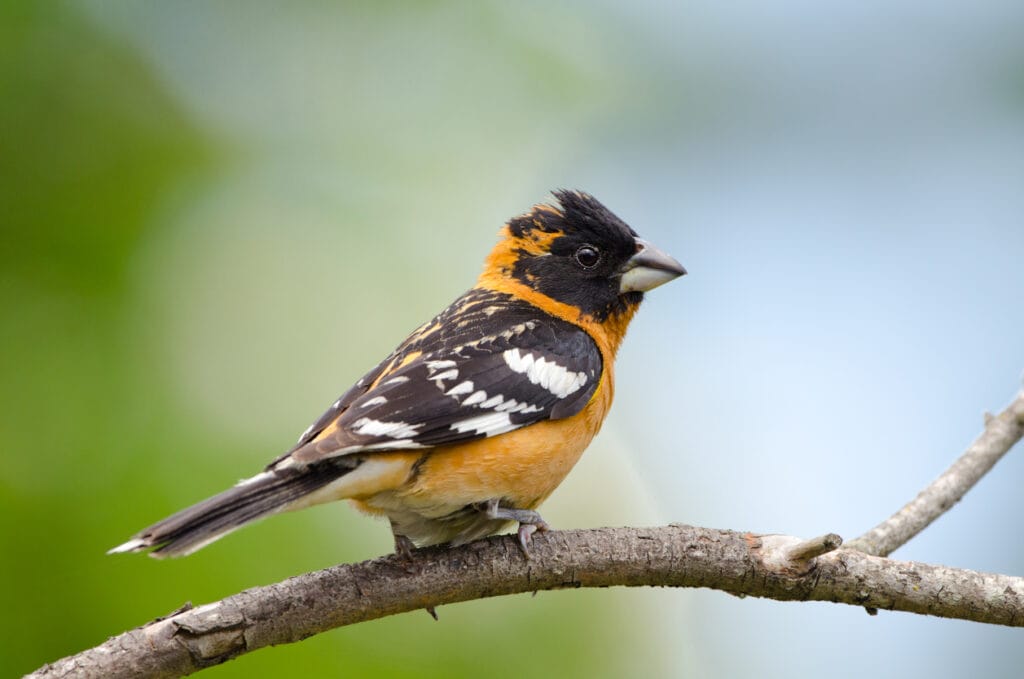
- Scientific name: Pheucticus melanocephalus
- Wingspan: 12.6 in
- Length: 7.3 in
- Weight: 1.2-1.7 oz
The name grosbeak refers to how parrot-like this bird’s bill actually is. It’s one of the main identifying features.
Besides the thick beak, the rich orange chest that fades to a yellow belly also stands out from other varieties.
This hefty songbird is commonly spotted on the western coast of America, and it happens to be a close relative to the Northern Cardinal.
19. Northern Cardinal
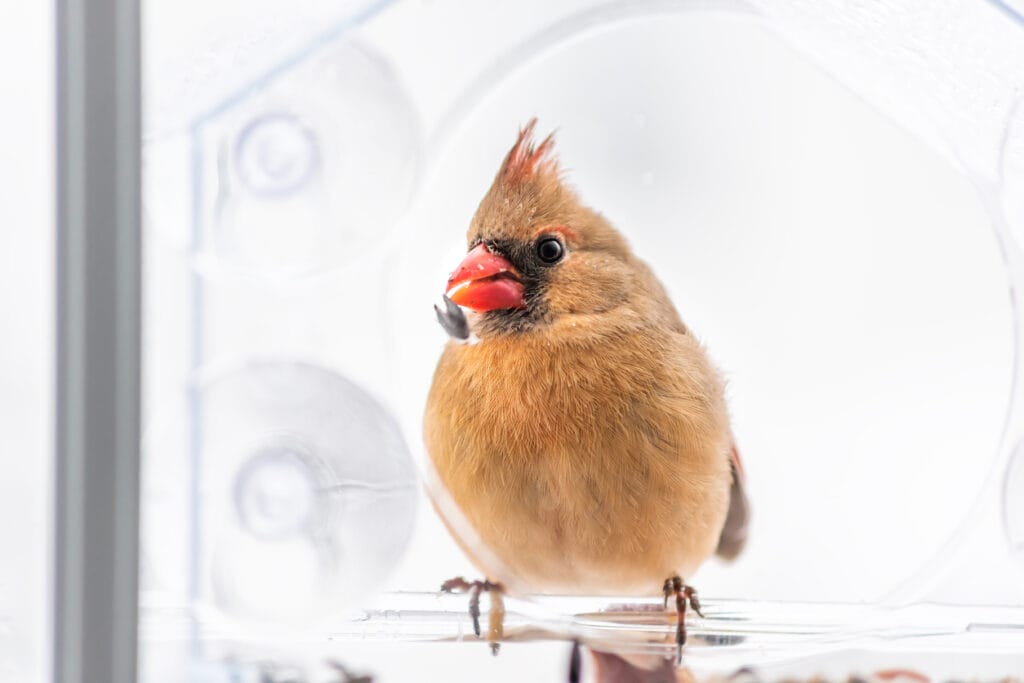
- Scientific name: C. cardinalis
- Wingspan: 12 in
- Length: 8.7 in
- Weight: 1.5 oz
Although it’s in the same family as the Black-headed Grosbeak, there’s no mistaking the two together.
Top Tip: The Northern Cardinal has a very prominent orange crest in the same blood-shot orange shade as their underparts. The tips of the wings are slightly darker, and the face is a solid black splotch.
When it fans out the crest and hunches down, it creates the iconic profile that sets it apart from other birds of the Cardinals genus.
20. Baltimore Oriole

- Scientific name: Icterus galbula
- Wingspan: 9-12 in
- Length: 8 in
- Weight: 1.5 oz
You might know the name from the baseball team, but the Baltimore Oriole is more than just a mascot.
Most male birds of the genus are orange-chested with black and yellow markings. However, the Baltimore, Orchard, and Bullock’s Orioles are the most common in America.
21. Varied Thrush
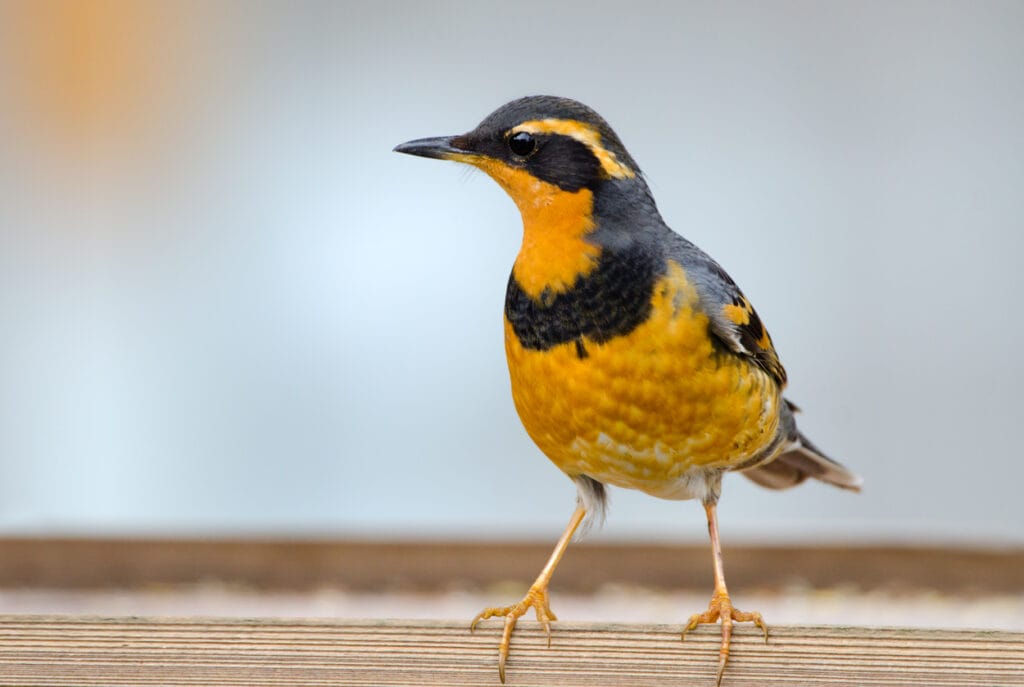
- Scientific name: Ixoreus naevius
- Wingspan: 12-17 in
- Length: 8-12 in
- Weight: 3 oz
The Varied Thrush is a common bird all across the western coast of North America, going north to Canada for its breeding season.
It has an orange neck, chest, and belly cut with a band of black plumage that almost looks like a collar or a necklace.
Varied Thrushes can be tracked with their successive flute-like songs in the evening and early morning.
Wrapping Up
Spotting birds with orange chest plumage is a part of every birdwatcher’s routine. There are way more varieties than you can imagine.
However, identifying them is not all that hard once you narrow down your options by location, season, and distinctive features.
It all comes down to training your eye to pick the subtle differences!
FAQ
Certain seeds provide birds with pigment including orange pigment on the breast.
In some cultures, orange symbolized balance and harmony.






